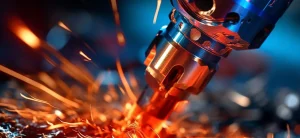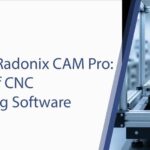Exploring the Creative Frontiers: How CNC Technology Revolutionizes Artistic Expression
In an age where art and technology increasingly intersect, CNC technology stands as one of the most transformative forces in modern creative industries.
What once required painstaking manual effort can now be realized through digitally precise automation, opening entirely new dimensions for artists, designers, and innovators.
The ability to turn imagination into exact, repeatable, and scalable works of art is no longer the privilege of factories alone—it’s a revolution empowering the creative mind.
At Radonix, where advanced CNC controller design meets industrial precision, innovation is not limited to manufacturing efficiency—it extends to artistic empowerment. CNC technology doesn’t replace creativity; it amplifies it.
Precision and Complexity: Expanding the Boundaries of Art
Precision is the defining strength of CNC systems. Through computer numerical control, artists can execute intricate designs with micrometer accuracy, reproducing exact patterns again and again without losing artistic integrity.
This capability allows creators to push the boundaries of complexity—from geometric sculptures to multi-layered textures in metal, wood, or resin.
The Power of Controlled Precision
CNC’s programmable accuracy transforms the artistic process. Each line, curve, and contour can be digitally sculpted, simulated, and refined before the first material cut. This not only reduces waste but also gives artists complete control over structure and proportion.
Whether it’s the delicate engraving of jewelry, precision wood inlays, or metal art installations, CNC systems enable flawless detail that once required decades of craftsmanship.
By merging creative vision with digital accuracy, artists no longer ask what’s possible—they define it.
Versatility Across Materials: Expanding Creative Mediums
Unlike traditional tools designed for specific crafts, CNC technology adapts across a wide spectrum of materials. Artists can engrave wood one day, carve marble the next, and finish the week with aluminum or acrylic—all using the same control principles.
This versatility makes CNC machines the ultimate creative partner, bridging material science and artistic freedom.
Artistic Freedom in Material Experimentation
Each material tells its own story, and CNC allows artists to explore those narratives. For example:
- Wood and bamboo highlight organic warmth, perfect for furniture and decorative art.
- Metal and alloys convey permanence and industrial beauty in sculpture.
- Acrylics and resins create luminous surfaces that play with light and color.
By shifting effortlessly between mediums, artists can combine multiple materials in hybrid artworks—melding natural textures with mechanical precision. This diversity fuels experimentation and drives the evolution of modern design.
Streamlining Production: From Concept to Creation
In traditional art and craft, the journey from concept to completion could span months. CNC automation reduces that dramatically by eliminating repetitive manual tasks and enabling rapid prototyping. Automation doesn’t diminish creativity—it accelerates it.
CNC software allows creators to visualize the final product in 3D before machining begins. Adjustments can be made instantly, saving both time and resources. Artists can focus on design refinement rather than repetitive shaping or cutting. The result is faster production without compromising authenticity.
Enhancing Workflow and Scalability
Efficiency also unlocks opportunity. Independent designers can scale from one custom piece to multiple reproductions with consistent quality, supporting both art exhibitions and commercial demand. For studios or design houses, CNC systems offer reliability, ensuring that every iteration meets the same meticulous standard.
When combined with sustainable practices, digital workflows even minimize waste—aligning art with eco-conscious production values.
Customization and Personalization: The New Art Economy
The modern art consumer values individuality. CNC technology makes it possible to achieve mass customization—where each creation feels personal, not produced. Whether for customized interior décor, personalized jewelry, or one-off sculpture commissions, CNC systems deliver precision tailored to human imagination.
Crafting Individual Expression
Through adjustable digital templates, artists can alter designs for size, material, or pattern variations, making each version unique. This flexibility fuels collaborations between artist and client, where the customer’s story becomes part of the final design.
Personalization is no longer an optional feature—it’s the foundation of the connection between the artist and their audience. And CNC machines make that level of detail achievable, scalable, and cost-efficient.
Bridging Art and Technology: A Creative Alliance
The most exciting aspect of CNC technology lies in its ability to merge creativity with engineering discipline. Artists no longer work in isolation—they collaborate with software specialists, mechanical engineers, and digital fabricators. This synergy produces results that neither art nor technology could achieve alone.
Digital Design and Machine Intelligence
Modern CAD/CAM software allows artists to translate ideas directly from sketches or 3D models into executable CNC code. This bridge between concept and execution fosters interdisciplinary innovation—from architectural installations to experimental art pieces that blend motion, light, and sound.
Radonix exemplifies this bridge. By developing advanced controller systems that respond to artistic precision, Radonix enables smoother motion control, faster response rates, and higher accuracy—making machines intuitive partners for human creativity.
The Future of Artistic Expression Through CNC
As artificial intelligence and machine learning integrate with CNC platforms, the next chapter of creativity will go beyond precision into predictive design—where systems anticipate and enhance artistic choices. The future will see artists using CNCs not merely as tools but as collaborators capable of interpreting aesthetic intent.
This transformation reflects a broader truth: technology does not confine creativity—it expands it. The artists of tomorrow will harness CNC technology not to replace their touch, but to amplify their reach, their ideas, and their impact.









